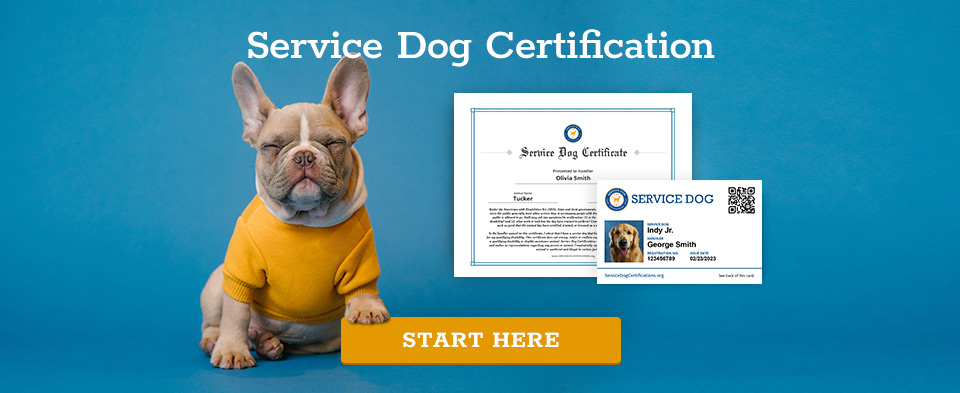How a Service Dog Knows When It’s Time For You to Take Medicine

Service dogs can help their handlers by reminding them to take medication. These highly trained dogs know when it’s time for their handler to take medicine through routine recognition, alarm responses, scent detection, and awareness of physical and behavioral cues. Training a service dog to do this is one of the many service dog tasks that can meet service dog requirements for training. Keep in mind you also need a qualifying disability to have a service dog.
We’ll explore five main ways service dogs can be trained to assist with medication reminders, including practical training tips, potential challenges, and the emotional and health impacts of having a service dog.
- Using Routine to Remind You of Medication
- Training Your Dog to Respond to Alarms or Sound Cues
- Using Scent Detection to Signal Medication Needs
- Detecting Behavioral Cues to Remind You of Medication
- Detecting Physical Symptoms to Signal Medication
1. Using Routine to Remind You of Medication
Many medical conditions, such as epilepsy, heart disease, or mental health disorders, are optimally given at specific times daily. Dogs thrive on routine, making them excellent candidates for learning to associate certain times or daily activities with medication reminders.
Dogs also have an internal clock that allows them to sense the passage of time in their own way. For people whose condition requires strict adherence to a schedule, service dogs can be trained to signal the need for medication at the same time each day.
For example, a person with epilepsy needs to take medication at 8:00 AM and 8:00 PM. The dog learns to associate the morning routine and the evening wind-down with medication and nudges the handler just before each dose.
How a Dog Knows: Dogs pick up on patterns in their handler’s behavior. By following a consistent medication schedule, the dog learns the daily routine associated with medication, such as waking up, going to a specific room, or reaching for the pillbox.
Why It Works: Dogs are creatures of habit, and their ability to learn and anticipate routines means they can remind you to take medication by associating their actions with the time of day.
How to Train:
- Establish a routine
Begin by taking your medication at the same time each day. Use consistent behaviors, such as sitting in the same chair or retrieving a pillbox, that the dog will associate with medication time. - Use a verbal cue
Pair the routine with a cue like “meds time” and reward your dog when they stay nearby during the medication process. - Positive reinforcement
Over time, your dog will learn to anticipate these cues and can be trained to nudge or paw at you when it’s time for medication.
Challenges: Dogs might not always respond to time alone — certain distractions or unusual activities in your day might throw off the routine. To counter this, add an alarm system or specific visual cues to reinforce the time-based behavior.
2. Training Your Dog to Respond to Alarms or Sound Cues
Many individuals rely on alarms or reminders to signal when it’s time to take medication. Service dogs can be trained to respond to specific sounds and alert their handler when the alarm goes off. This is particularly useful for people with ADHD, memory impairments, or those recovering from surgery who may not always remember on their own.
For example, a person suffering from severe depression has an alarm for antidepressants at noon. When the alarm rings, the psychiatric service dog nudges them until they take the medication.
How a Dog Knows: Dogs can be conditioned to associate an alarm sound with a task. The dog learns that when a specific sound goes off, they should alert their handler, whether it’s by nudging, barking, or bringing an object like a pillbox.
Why It Works: Dogs are responsive to auditory stimuli. When paired with a reward system, they quickly learn that the sound of an alarm means their handler needs to take action.
How to Train:
- Use a consistent alarm
Choose a reliable sound, such as a phone or timer, to serve as the medication reminder. - Introduce the alarm
Each time the alarm goes off, say a command like “alert” and encourage your dog to nudge you until you respond. - Reinforce regularly
Over time, your dog will recognize the sound as the cue to prompt you to take your medication.
Challenges: Some dogs might get confused by similar sounds or become desensitized if they hear alarms frequently without reinforcement. To avoid this, keep training sessions consistent and focused, with rewards tied only to the specific alarm used for medication.
3. Using Scent Detection to Signal Medication Needs
In cases of medical conditions like diabetes, adrenal insufficiency, or thyroid imbalances, the body’s chemistry can change when medication is required. Service dogs can be trained to detect even the slightest shifts in scent and alert their handler accordingly.
For example, a diabetic patient’s blood sugar drops, leading to a change in their body’s scent. The dog detects the change and nudges the handler, prompting them to check their blood sugar and take insulin if necessary.
How a Dog Knows: Dogs have an extraordinary sense of smell and can detect changes in a handler’s scent due to fluctuations in blood sugar, hormone levels, or other physical factors. For instance, people with diabetes may emit a different odor when their blood sugar drops, prompting the dog to alert the handler.
Why It Works: With around 300 million olfactory receptors, dogs can identify chemical changes in their handler’s body far earlier than most technological devices. This makes them ideal for managing conditions where medication needs can change quickly and unexpectedly.
How to Train:
- Collect scent samples
Capture your scent during times of low blood sugar or when your body chemistry changes, and store these samples. - Pair with a command
Present the scent to your dog while using a command like “check” and reward them for responding to it. - Gradually introduce real-life scenarios
As your dog gets used to the scent, reinforce their response by rewarding them for detecting changes in your body in real situations.
Challenges: Training dogs for scent detection requires significant time and patience, as some dogs may not pick up on the specific scent change immediately. If you’re not experienced with training dogs, working with a professional trainer for scent-based tasks is recommended.
4. Detecting Behavioral Cues to Remind You of Medication
For individuals with mental health conditions like anxiety, PTSD, or depression, forgetting to take medication can lead to subtle but critical changes in behavior. Dogs are naturally sensitive to their handler’s body language and can be trained to detect these shifts, reminding the handler to take their meds.
For example, a person with anxiety tends to pace and fidget when they forget their medication. The service dog learns to notice this pattern and nudges the handler as a reminder to take their meds.
How a Dog Knows: Dogs can observe changes in your behavior, such as increased fidgeting, pacing, or confusion, which may indicate a missed medication dose. They can be trained to intervene when they notice these behavioral shifts.
Why It Works: Dogs are highly observant of human body language and emotional cues. When they detect that their handler is not behaving as usual, they can alert them to the potential need for medication.
How to Train:
- Recognize behavioral changes
Take note of how your behavior changes when you forget your medication — this might include restlessness or irritability. - Reward attentiveness
When your dog stays close or reacts to these changes, use a command like “remind” and reward them for their alert behavior. - Reinforce over time
Eventually, your dog will associate your behavioral cues with the need for medication and alert you automatically.
Challenges: Training for behavioral detection requires the handler to be self-aware and consistently rewarding the dog’s attentiveness. Some dogs may need extra encouragement to recognize subtle changes.
5. Detecting Physical Symptoms to Signal Medication
For individuals with conditions like anxiety disorders, PTSD, or other conditions that cause physical symptoms (such as shallow breathing or increased heart rate), service dogs can be trained to detect these changes and alert the handler to take their medication.
For example, a person with PTSD begins to breathe rapidly during a panic attack. The service dog detects the physical symptoms and prompts the handler to take their medication.
How a Dog Knows: Dogs are attuned to their handler’s physical presence and can pick up on changes like an increased heart rate or muscle tension. When they detect these symptoms, they prompt the handler to take their medication.
Why It Works: Dogs are sensitive to even slight physical changes in their handler. By noticing early signs of anxiety or other symptoms, they can intervene before the condition worsens.
How to Train:
- Identify physical symptoms
Track how your body reacts when you need medication, such as heavy breathing or sweating. - Reward alert behavior
When your dog notices these symptoms, reward them for staying close or nudging you. - Reinforce with real-life situations
Over time, reward the dog for alerting you when they sense these symptoms in real time.
Service Dogs Help You Stay on Track With Medication
Service dogs offer invaluable assistance for people who need regular medication. By recognizing daily routines, responding to alarms, detecting scent changes, observing behavior shifts, and even retrieving medication, service dogs provide life-changing support for managing chronic conditions.
While training can take time, the benefits of having a service dog to help with medication reminders are significant, improving independence and overall health outcomes. With the right approach and persistence, you can teach your dog to assist with your medication needs effectively.

About the Author: The writing team at Service Dog Certifications is made up of folks who really know their stuff when it comes to disability laws and assistance animals. Many of our writers and editors have service dogs themselves and share insights from their own experiences. All of us have a passion for disability rights and animals.
Latest Posts

Can you bring a service dog to a museum?
Yes, you can bring your service dog to the museum! All the major U.S. museums welcome guests with service animals in accordance with the Americans with Disabilities Act (ADA). There are some areas, however, that might be off-limits. Here’s what you should know if you plan to spend a day at the museum with your […]

Read More

How to Bring a Service Dog to Six Flags Magic Mountain
Service dogs are welcome at Six Flags Magic Mountain so long as they are, according to Six Flags, “trained to do work or perform tasks for people with disabilities.” Of course, your dog must be housebroken and remain on a leash or harness and under your control while at the park — and the park […]

Read More

When Stores Can Refuse Your Service Dog
According to the Americans with Disabilities Act (ADA), service dogs should be allowed into any store most of the time. A store owner can legally exclude a service dog if they are actively growling, snapping at, or frightening customers, or if the dog is obviously out of the control of its owner. Ordinary behaviors — […]

Read More